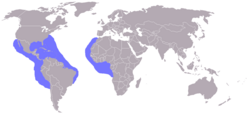AY Honors/Species Account/Negaprion brevirostris
Template:Taxobox Template:Sharksportal
The lemon shark, Negaprion brevirostris, is a well studied shark belonging to the family Carcharhinidae. It is shaped like a lemon.
Distribution and habitat
It is found mainly along the subtropical and tropical parts of the Atlantic coast of North and South America. This species can be found as well in Pacific islands of Polynesia - French Polynesia - Tahiti, Cook Islands, Tongas.
Reproduction
Lemon sharks are viviparous, females giving birth to between 4 and 17 young every other year in warm and shallow lagoons. The young have to fend for themselves and remain in shallow water near mangroves until they grow larger. With increasing size, the sharks venture further away from their birth place. At maturity at a size of 1.5 to 2 m and an age of 12 to 15 years, they leave shallow water and move into deeper waters offshore. However, little is known of this life stage. Maximum recorded length and weight is 340 cm and 183 kg. Can be extremely aggressive and protective if young sharks are around.[1]
Recent work in genetics by Drs Kevin Feldheim, Sonny Gruber and Mary Ashley may suggest that adult sharks move over hundreds of km to mate, or populations far apart may have been separated in recent time. Further research in this area would be of immense importance for the understanding of the lemon shark's breeding behaviour and ecology.
Importance to humans
Lemon sharks are a popular choice for study by scientists as they survive well in captivity, unlike many other species such as great white sharks, which die in captivity because they refuse food. The species is the best known of all sharks in terms of behaviour and ecology, mainly thanks to the enormous effort of Dr. Samuel Gruber at the University of Miami who has been studying the lemon shark both in the field and in the laboratory since 1967. The population around the Bimini Islands in the western Bahamas, where Dr Gruber's field station, Bimini Biological Field Station, is situated, is probably the best known of all shark populations. As of 2007, it is experiencing a severe population decline and may disappear altogether due to destruction of the mangroves for construction of a golf resort.
See also
References
- Template:IUCN2006 Database entry includes justification for why this species is near threatened
- Template:ITIS
- Template:FishBase species
- Washington Post, 2005, Aug. 22nd: "Scientists Fear Oceans on the Cusp Of a Wave of Marine Extinctions"
External links
cs:Žralok citrónový de:Zitronenhai fr:Requin citron nl:Citroenhaai pt:Tubarão-limão sk:Žralok citrónový fi:Sitruunahai sv:Citronhaj

